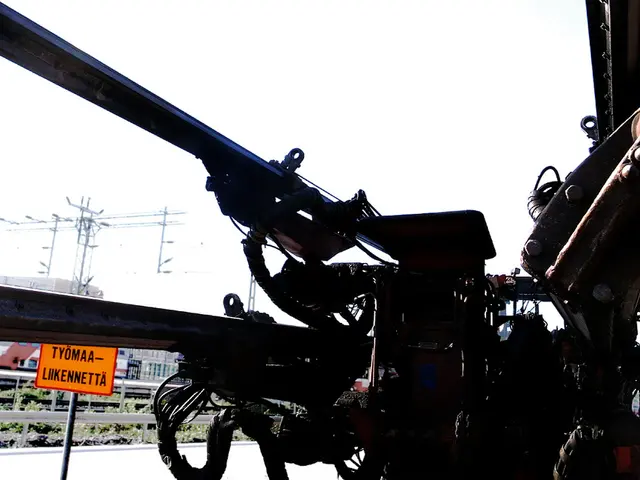Could Humans Endure Mars' Conditions? Insights on Radiation, Dust Storms, and Gravity's Effects
Stepping onto a Mars-scape is like venturing onto a desolate, rusty world, where the horizon stretches out in an endless, silent sweep under a salmon-pink sky. The icy cold is sharper than Antarctica's, and every breath is a chilling reminder that this isn't our turf. Yet, the burning question lingers: could we ever call Mars our second home? Gone are the days of this being a mere science fiction dream; it's now a genuine conundrum scientists are frantically seeking answers to. The responses are mind-boggling, full of hurdles that test not only our technology, but the very core of our human resilience. If you've ever gazed up at the night sky and wondered, "Could I survive up there?"-you're not alone. buckle up and take a seat as we delve into the real science behind humanity's most daring adventure.
Mars' Atmosphere: Thin, Hostile, and Brutal
Mars' atmosphere is a world apart from Earth's life-giving blanket. It's so thin-about 1% the density of Earth's-that you'd barely feel any wind, even during a dust storm. The air is bereft of oxygen, replaced by a deadly 95% carbon dioxide. That means a single lungful of Martian air could be lethal. This environment supplies almost no protection from the sun's ultraviolet rays, making sunscreen seem pointless. Picture living in a pressurized submarine on dry land, where stepping outside sans a suit spells doom. Every breath, every move on Mars demands meticulous engineering for survival.
Radiation: The Invisible Menace
Unlike Earth, Mars doesn't boast a strong magnetic field or a thick atmosphere to shield against space radiation. Cosmic rays and solar particles pelt the surface relentlessly. On Mars, you'd endure radiation levels up to 50 times higher than on Earth. Prolonged exposure raises cancer risks, damages organs, and even alters DNA. NASA scientists fear that astronauts could hit their lifetime radiation limit in just a few years. To survive, habitats must be built underground or fortified with thick walls-perhaps even utilizing Martian soil itself for protection. It's a grim reminder that the most fearsome threats on Mars are typically unseen.
Martian Dust: More Than a Nuisance
That red Martian dust is everywhere-literally. It's so fine it can float in the air for months on end and stick to spacesuits, machinery, and solar panels. But it's not just irritating; it's potentially toxic. The dust contains perchlorates, chemicals that are harmful to human health and could interfere with thyroid function. Inhaled particles might harm lungs, making every breath a risk. Equipment can malfunction or break down as dust builds up, and solar panels can lose power due to accumulated dust. Imagine striving to keep your house clean while dealing with dust that could poison, and you've got a taste of what living on Mars is like-except it's much harder.
Low Gravity: Strange Effects on the Human Body
Gravity on Mars is only about 38% of Earth's. At first, that sounds fun-imagine leaping higher with less effort. But our bodies are fine-tuned for Earth's gravity, and long-term exposure to low gravity leads to muscle atrophy, bone loss, and changes in the heart's function. Astronauts on the International Space Station-which experiences even lower gravity-must exercise constantly to stay healthy. On Mars, we'd need to invent new workouts and even reconsider how we move. Something as simple as pouring a glass of water or climbing stairs becomes an alien experience. It's not just a physical challenge; it's a psychological one too.
Temperature Extremes: The Deep Freeze
Mars is all about icy extremes. Daytime temperatures near the equator might reach a balmy 20°C (68°F), but at night or near the poles, the mercury plummets to -100°C (-148°F) or lower. These dramatic fluctuations make survival tricky; insulation and heating are obligatory for any habitat. Exposure to the Martian night could freeze water, electricity, electronics, and even people in minutes. Constructing structures that handle both scorching sun and freezing cold is a formidable engineering feat. Imagine camping in the coldest desert on Earth, but with precious few resources and even less chance of help if something goes awry.
Water: Scarce but Not Impossible
Water is the lifeblood of any colony, and on Mars, it's scarce but not extinct. Scientists have discovered frozen water at the poles and signs of salty liquid brines beneath the surface. Extracting and purifying this water is a monumental technical challenge. Future Martians may need to melt ice, filter out harmful chemicals, and recycle every drop. NASA's Perseverance rover is already testing oxygen production from Martian CO2, a milestone in rendering Mars less inhospitable. But for now, each drop of water on Mars is as precious as gold in a desert.
Food Production: Farming in Alien Soil
Sowing seeds in Martian soil and expecting a crop isn't in the cards. The regolith (soil) is laden with toxic perchlorates and lacks vital nutrients. Hydroponics-growing plants in water with supplemented nutrients-offers hope, but it calls for energy, water, and careful management. Scientists are playing around with ideas to "clean" Martian soil, use bacteria to fix nitrogen, and even engineer crops to prosper in extreme conditions. Mars-grown farmers will need to be part botanist, part chemist, and part engineer. Each head of lettuce will be a testament to ingenuity.
Oxygen Supply: Every Breath Matters
On Mars, oxygen is the ultimate luxury. Since the air is almost pure carbon dioxide, breathing necessitates the use of tanks or intricate machines to split CO2 into oxygen. NASA's MOXIE experiment has already produced small amounts of oxygen on Mars, a promising start. But scaling this up for a whole community is an uphill battle. Every leak or malfunction could spell disaster. It's humbling to realize that, on Mars, every breath is as precious as diamonds.
Psychological Challenges: Isolation and Desolation
Mars isn't just physically tough; it's emotionally grueling too. Imagine years or months with only a handful of people, millions of kilometers away from Earth. Communication delays mean no real-time chats, no immediate assistance in an emergency. Mission control can't swoop in to rescue you from every predicament-Mars-dwellers will need to be resourceful and self-reliant. Picture the solitude of a remote island, with the ocean replaced by millions of miles of empty space-that's what living on Mars feels like, only far more challenging.
Communication Delays: The Tyranny of Distance
Engaging in conversations with Earth from Mars isn't like a phone call. Depending on their positions in orbit, messages might take anywhere from 4 to 24 minutes to travel each way. That means no real-time conversations, no quick help in emergencies, and a sense of being truly estranged. Having mission control intervene in every problem isn't an option-Mars-dwellers will need to dig deep and be creative. It's a bit like being stranded on a desert island, but with the ocean replaced by voids of nothingness.
Power Generation: Keeping the Lights On
Energy is the lifeblood of any Mars mission. Solar panels seem like the obvious choice, but Mars' dust storms can darken the sky for weeks, severely cutting power output. Nuclear reactors offer more consistent energy but come with their own challenges. Every watt counts-heating habitats, recycling air and water, and running life-support systems all depend on reliable power. On Mars, a blackout isn't merely inconvenient; it could be disastrous.
Suiting Up: Life Inside a Spacesuit
Donning a bulky, pressurized suit is a must every time you step outside on Mars. These suits must protect against radiation, dust, and extreme cold while allowing you to move and work. Current suits are heavy, clunky, and prone to wear and tear. Engineers are racing to design lighter, more flexible models. Every walk outsidewill feel like a military operation, and a torn glove or malfunctioning zipper could be lethal.
Landing on Mars: The Seven Minutes of Terror
Even getting to Mars requires a herculean effort. The atmosphere is too thin for parachutes to work well, but it's too thick to burn up spacecraft if they enter too fast. Engineers refer to the descent as the "seven minutes of terror"-the time it takes for a lander to transition from blazing entry to a safe touchdown. Each mission is a nail-biter, and landing humans will push the stakes even higher. It's a poignant reminder that, on Mars, the journey is fraught with peril.
Building Habitats: Crafting a Home on the Red Planet
Martian homes must be airtight, insulated, and strong enough to withstand radiation, dust storms, and temperature extremes. Some ideas involve inflatable modules, while others suggest utilizing 3D printing technologies to create shelters from Martian soil. Underground habitats offer the best protection from radiation but add complexity and costs. Every design choice, every material choice must balance safety, comfort, and economy. Building homes on Mars feels less like a paint-choosing party and more like a high stakes gamble on engineering.
Medical Emergencies: No Room for Errors
Medical care on Mars will be limited. Hospitals, specialist doctors, and quick trips home for surgery are luxuries unavailable to Martians. Astronauts must be trained in emergency medicine, dentistry, and even minor surgery. Supplies must be conserved, and telemedicine is handicapped by communication delays. An everyday illness or injury could become life-threatening. Every crewmember's health will be a collective responsibility-one person's broken leg could jeopardize the whole team.
Martian Dust Storms: Nature's Fury Unleashed
Martian dust storms can cover the entire planet, blocking sunlight and plunging temperatures for weeks on end. While the winds are weaker than Earth's, the fine dust can infiltrate machinery, clog air filters, and scratch visors. Solar power reduces, navigation becomes treacherous, and the landscape changes. Surviving a storm means hunkering down and relying on stored supplies-it's like living in a world where the weather itself is trying to kick you out.
Adapting Technology: Innovation or Bust
Living on Mars will put technology to the test. Every system-from life support to communication-must be robust, repairable, and energy-efficient. Spare parts will be rare, so recycling and reusing technology will be crucial. Engineers are working on advanced materials, smarter robots, and ways to use local resources. In many ways, a Mars colony will be a trial by fire for human ingenuity-failure is not an option.
Human Spirit: The Drive to Explore
Despite all the challenges, the dream of living on Mars persists. There's a part of us that yearns to go farther, to test ourselves against the unknown. Our history is a tale of courage, curiosity, and hope overcoming seemingly impossible odds. Mars represents the next chapter in our cosmic journey-a place where humans could reinvent themselves, or learn the realization of our fragility. The risks are enormous, but so is the reward: a new chapter in our ongoing space adventure.
Ethical and Environmental Questions: Should We Go?
Sending humans to Mars isn't just a technical or medical challenge-it's a moral one. Some scientists worry about contaminating Mars with Earth life, upsetting any hopes of discovering indigenous creatures. Others ask if we should spend billions on Mars instead of addressing pressing issues on Earth, like poverty and climate change. These debates are messy, emotional, and mirror our deepest hopes and fears. Yet, they're questions we must answer before setting foot on another planet.
Looking Forward: Are We Ready for Mars?
As of May 2025, science has made impressive strides, but the road to Mars remains long and uncertain. Each advancement brings us closer, yet reminds us of the mysteries we still haven't cracked. The risks are real, and the challenges are immense-but so is the potential for inspiration, growth, and unity. One thing is certain: Mars will put technology, ingenuity, and human resolve to the test. Will we rise to the challenge, or will Mars remain forever out of reach?
Andrew D. WilsonEnrichment Data:Establishing a human settlement on Mars is a complex endeavor that involves addressing numerous challenges while leveraging recent advancements in technology. Here's a breakdown of the current state of affairs:
Current Advancements
- Robotic and Technological Advancements:
- Robots and Spacecraft: NASA's Perseverance rover and Mars 2020 mission are currently exploring Mars, gathering valuable data and paving the way for future manned missions.Companies like SpaceX and Blue Origin are making strides in space travel technology, particularly in regards to reusable rockets.
- Greenhouse Technologies: NASA's Veggie system allows plants to be grown in Martian soil, demonstrating the possibility of future food production on Mars.
- Radiation Shielding: Research is underway to develop radiation-resistant materials that can be used in Martian habitats to protect crew members from harmful radiation.
- Mission Planning and Timeline:
- NASA's Artemis program aims to return humans to the Moon by 2024 and establish a sustainable human presence there as a stepping-stone for future Mars missions.
- NASA has set a goal to send humans to Mars by the mid-2030s, with plans for a lunar base serving as a starting point for manned missions to Mars.
Challenges
Environmental Challenges
- Martian Atmosphere: The thin atmosphere offers little protection from cosmic radiation, which calls for innovative radiation shielding solutions.
- Dust Storms: Mars' dust storms can cause malfunctions in equipment and threaten life support systems-contingency plans and redundancies need to be built into any Mars mission.
- Temperature Extremes: The extreme temperature swings require adequate insulation and heating for habitats and life support systems.
Resource Challenges
- Water: Scientists believe that water can be extracted from the Martian soil and ice caps. However, whether this water will be safe for drinking, without additional purification, remains unclear.
- Food Production: Sustainable food systems will be essential for long-term Mars missions, with hydroponics and vertical farming among potential solutions.
- Oxygen: NASA's MOXIE experiment successfully produced oxygen from Martian carbon dioxide, signifying an important breakthrough, but further advancements in oxygen production will be crucial for sustained human life on Mars.
Operational Challenges
- Power Generation: Solar panels offer a viable power source, but Mars' dust storms can significantly reduce their efficiency.Other options for power generation include nuclear reactors and advanced batteries.
- Communication: Mars' distance from Earth makes real-time communication difficult, with delays of up to 24 minutes each way. Research is being conducted to develop faster communication methods and networks.
- Suiting Up: Space suits must be designed to protect against Mars' harsh environment, while also offering mobility and adaptability for various tasks. Research is ongoing to develop lighter, more advanced spacesuits.
Human Factors and Ethical Concerns
- Mental Health: The isolation and confinement inherent in a long-duration Mars mission can have detrimental effects on mental health. Counselors, therapeutic interventions, and engaging social activities will be critical components of any mission's crew support systems.
- Radiation Exposure: Prolonged exposure to radiation has the potential to increase cancer risks and cause other health problems. Time spent on Mars would need to be balanced with appropriate rest periods on Earth.
- Ethical Considerations: There are debates about the environmental impact of human habitation on Mars, as well as the ethical implications of colonizing another planet. Proper guidelines, regulations, and international cooperation will be necessary to address these concerns.
Addressing these challenges requires not only technological advancements and comprehensive planning but also international collaboration, investment in research, and the determination to overcome the unknown.
- Mars' atmosphere is a stark contrast to Earth's, offering scant protection for human survival, as it is 1% the density of Earth's, bereft of oxygen, and host to deadly levels of carbon dioxide.
- The risk of radiation on Mars far surpasses that on Earth due to the absence of a strong magnetic field and thick atmosphere, exposing astronauts to potentially lethal levels of cosmic rays and solar particles.
- Martian dust, finer than that on Earth, poses both a nuisance and a health hazard, as it is toxic, potentially affecting the thyroid and causing lung issues.
- Reduced gravity on Mars may initially seem advantageous, but it leads to muscle atrophy, bone loss, and cardiac complications over time, necessitating the development of new workouts and movement techniques.
- Mars experiences extreme temperature swings, with daytime temperatures at the equator rarely exceeding 20°C (68°F), and freezing nighttime temperatures or polar conditions dropping below -100°C (-148°F).
- Water, though scarce on Mars, is not entirely absent, with signs of salty liquid brines beneath the surface and ice at the poles, presenting challenges in extraction, purification, and recycling.
- Food production on Mars will necessitate hydroponics or engineered crops tailored for extreme conditions, as Martian soil is inhospitable to conventional agriculture.
- Oxygen will be a precious commodity on Mars, with current experiments aimed at producing small amounts for human use, such as NASA's MOXIE, which converts carbon dioxide into oxygen.
- Psychological challenges stemming from isolation, desolation, and a prolonged sense of estrangement from Earth are endemic to living on Mars, as communications take anywhere from 4 to 24 minutes to travel and may lack real-time assistance in emergencies.
- Power generation will be essential to maintain life support systems, heat habitats, and operate machinery. However, energy efficiency will be crucial, as power outages on Mars can be disastrous due to the scarcity of resources and difficult resupply missions.
- Space suits designed for Mars must offer protection against the harsh environment, radiation, and extreme temperatures while still allowing flexibility for various tasks.
- The quest to establish a human settlement on Mars puts technology, ingenuity, and human resolve to the test, as engineers must overcome numerous environmental, resource, operational, human factors, and ethical challenges while leveraging advancements in technology.








